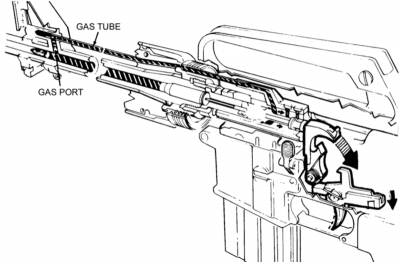Direct impingement

Direct impingement is a type of gas operation for a firearm that directs gas from a fired cartridge directly to the bolt carrier or slide assembly to cycle the action.
Contents |
[edit] Evaluation
Unlike other gas operated firearms, direct impingement does away with a conventional gas cylinder, piston, and operating rod. The design is simpler in that high-pressure gas acts directly on the firearm's action, eliminating redundant parts, and thereby saving weight, lowering costs, and reducing the mass of the operating parts.
The main disadvantage of direct impingement is that the breech of the firearm becomes fouled more quickly. This is caused by solids from the high-temperature gas condensing as they cool and being deposited on the bolt face and primary operating mechanism. An analogy is that steam, another hot gas, will condense quickly in air and on cooler objects. Combustion gases contain a great deal of vaporized metals, carbon, and impurities which are in a gaseous state until they are deposited on the cooler operating parts. Thorough and frequent cleaning is required to ensure reliability.
Conversely, in a conventional gas cylinder/piston design such as the Heckler & Koch G36, most of the gas used to operate the firearm is isolated from the breech being contained within the gas cylinder and vented away from other working parts. Some alternative systems actually contain the gas completely and vent excess back into the barrel, such as the M1 Carbine and FN SCAR.
A further disadvantage is that combustion gases in contact with the bolt and bolt carrier cause excessive heating. This heating accelerates wear and drastically decreases the service life of critical operating parts such as the bolt, extractor, and extractor spring. It also dries up lubricant and makes the operating parts difficult to handle when clearing malfunctions.
[edit] History
The first experimental rifle using a direct impingement system was the French ENT 1901 Rossignol B1 rifle followed by Rossignol's B2, B4 and B5. The first successful production weapon was the MAS 40 adopted in March 1940.it inherited its system from the SE MAS 35 itself derived from the MAS modele 1928 and the MAS 1928/31. It incorporated some of the MAT 1931 technical solutions when it evolved into MAS 38 and MAS 39 under the supervision of the General Armament Enginer F. Massacrier. The existing MAS 40,tooling and blueprints were hidden during the occupation of France between 1940 and 1944. The production of the MAS 40 restarted immediately after the Liberation of France, the rifle being renamed MAS 44 and delivered to the French Navy Commandos Marine who used them in Indochina. The magazine release was modified in the MAS 44 A version. The French Army required the rifle to have a rail milled into the receiver for a scope mount, it became the MAS 44 B. Other modifications were incorporated into the MAS 49. it evolved into the MAS 49/56. The last french rifle to use a direct impingement system was the MAS 62. The MAS 49/56 were withdrawn from active service in 1990 after their replacement by the FA MAS. Some projects to reuse the MAS 49/56 as a semi automatic sniper rifle have been launched in 2007.
The Swedish AG-42 Ljungman, used a simplified direct-impingement operating system.
The premier current and only example of direct impingement system still in use is the AR-15/M16 rifle designed by Eugene Stoner who first designed the Armalite AR10. In the Stoner system, gas is routed from a port in the barrel directly to a chamber formed in the bolt carrier. The bolt acts as the piston and is sealed with small automobile-style piston rings.
The drawback of venting hot gasses into a closed receiver with tight tolerances between bolt carrier and receiver has been evidenced shortly after the adoption of the M16. Many American technicians and inventors have proposed systems to convert these weapons to a piston system like Walt Langendorfer's Rhino system.
Stoner himself designed a gas piston system for the Armalite AR18.
[edit] Bibliography
- Centre des archives de l'armement, Chatellerault. National Armament Archives Center.
- Huon, Jean. Proud Promise--French Semiautomatic Rifles: 1898-1979, Collector Grade Publications,1995,ISBN 0-88935-186-4